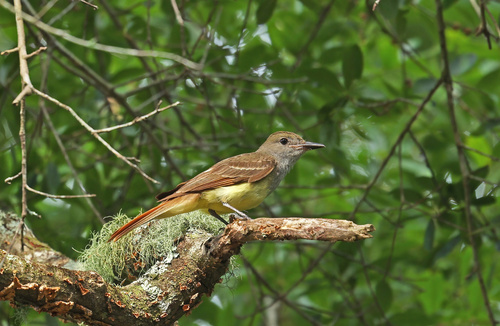
Great Crested Flycatcher
The Great Crested Flycatcher (Myiarchus crinitus) is a striking, medium-sized passerine bird known for its vibrant colors, distinctive calls, and bold behavior. It plays a significant ecological role as an insectivore, helping to control insect populations in its breeding and wintering habitats. This species is not typically associated with strong cultural symbolism, but its presence is often welcomed by birdwatchers as a sign of a healthy, diverse ecosystem.
17-21 cm
Length
28-33 cm
Wingspan
Least Concern
Conservation Status
Distribution
Breeds across eastern and east-central North America, from southern Canada south to Florida and the Gulf Coast. Migrates to Central America and northern South America (primarily Mexico, Guatemala, Honduras, and Colombia) for the winter. Occasional vagrant to the Caribbean islands.
Lifespan
Average lifespan in the wild is unknown, but likely around 5-7 years, with a maximum recorded lifespan of over 14 years.
Great Crested Flycatcher's Habitat
Habitat Types
Deciduous forests, Mixed woodlands, Forest edges, Open woodlands with clearings, Orchards, Parks
Climate Zones
Temperate, Subtropical
Adaptations
Strong legs and feet for perching on branches while hunting insects. Cavity nester, adapted to using pre-existing holes in trees or nest boxes.
Variations
No widely recognized subspecies, though some subtle plumage variations may exist across its broad range.
Appearance
Breeding Plumage
Plumage is similar year-round.
Seasonal Feather Changes
Minimal seasonal variation; may appear slightly duller in non-breeding plumage.
Sex Based Plumage Differences
Males and females have very similar plumage.
Notable Features
Erectile crest on head (often raised when agitated), Bright yellow belly, Rufous (reddish-brown) wings and tail, Grayish-brown upperparts, White throat and upper breast
Diet and Feeding
Primary Foods
Insects (flies, beetles, wasps, caterpillars, etc.), Spiders, Small fruits and berries (especially during migration and winter)
Foraging Behavior
Typically perches on a branch and sallies out to catch flying insects in mid-air. Also gleans insects and spiders from foliage. Occasionally hovers to pick insects from leaves or branches.
Specializations
Agile flight allows for capturing fast-flying insects. Wide gape for swallowing larger prey.
Seasonal Diet Variations
Diet is primarily insects during the breeding season. Incorporates more fruits and berries into the diet during migration and in wintering areas when insects are less abundant.
Behavior
Social Structure
Generally solitary or in pairs during the breeding season. May form small flocks during migration.
Communication
Loud, distinctive 'wheep' call, Series of rapid, chattering calls, Crest raising for visual display, Wing and tail flicking
Migration
Nocturnal migrant. Travels individually or in small, loose groups. Migrates relatively early in the fall compared to some other flycatchers.
Territorial or Group Behaviors
Highly territorial during the breeding season. Males defend territories through vocalizations and aggressive displays. Will mob potential predators, such as owls or hawks.
Conservation
Threats
Habitat loss and fragmentation (particularly loss of mature forests), Pesticide use (reducing insect prey), Competition with other cavity-nesting species (e.g., European Starlings), Collisions with buildings and other structures during migration
Protection Programs
Habitat conservation and restoration efforts, Promotion of sustainable forestry practices, Provision of nest boxes in suitable habitat, Monitoring programs (e.g., Breeding Bird Survey)
Local National Laws
Protected under the Migratory Bird Treaty Act in the United States and Canada.
Population Trend
Stable
Population Estimates
Global population estimated at around 9.8 million individuals.
Interesting Facts
Great Crested Flycatchers often include shed snakeskin in their nests.
The reason for this behavior is not fully understood, but it may deter predators or parasites.
They are known for their aggressive defense of their nests.
They will actively mob and chase away potential predators, including much larger birds.
They are one of the latest spring migrants to arrive on their breeding grounds.
This may be related to their reliance on flying insects, which become abundant later in the spring.
This is a highly vocal species.
Their calls are far carrying and can be heard at great distances.
They can hover like a hummingbird.
This flight adaptation is used during feeding.
Faqs about Great Crested Flycatcher
What do Great Crested Flycatchers eat?
They primarily eat insects, but also consume spiders, small fruits, and berries.
Where do Great Crested Flycatchers nest?
They nest in tree cavities, old woodpecker holes, or artificial nest boxes.
Are Great Crested Flycatchers aggressive?
They can be very aggressive in defending their nesting territory, but are not generally aggressive towards humans.
How can I attract Great Crested Flycatchers to my yard?
Providing a nest box in a suitable wooded area can attract them. Maintaining a healthy, insect-rich environment is also important.
What does the snakeskin in their nest do?
It is believed the snakeskin acts as a deterrent to potential nest predators or parasites.
Copyright @ Nature Style Limited. All Rights Reserved.
 English
English